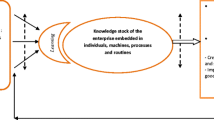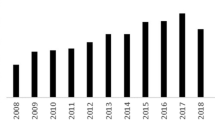Abstract
The creation and accumulation of knowledge are an increasingly collective phenomenon which goes beyond the borders of national economies forming networks that develop technological cooperation between firms. This strategy is the collection of significant amounts of S&T information that will eventually turn into innovations. In recent years, the term “open innovation” has become very popular, even if other formulas like “network innovation” or “collaborative innovation” have been also used for a long time. In this paper, we use an evolutionary approach to analyze the determinants of the globalization of MNCs’ R&D. By associating the theories of international economics and innovation management, we will therefore develop a new methodological framework to better understand the globalization of innovation process by building on synergies between different actors (firms, institutions).
Similar content being viewed by others
References
Andreff, W. (2003). Les Multinationales Globale. Paris: La Découverte.
Arena, R., & Lazaric, N. (2003). La théorie évolutionniste du changement économique de Nelson et Winter. Revue économique, 54(2), 329–354.
Asakawa, K., Song, J. Y., & Kim, S. J. (2014). Open innovation in multinational corporations. New insights from the global R&D research stream. In H. W. Chersbough, W. Vanhaverbeke, & J. West (Eds.), New frontiers in open innovation (pp. 157–168). Oxford: Oxford University Press.
Baldwin, C., & von Hippel, E. (2011). Modeling a paradigm shift: from producer innovation to user and open collaborative innovation. Organization Science, 22(6), 1399–1417.
Bartlett, D., & Ghoshal, S. (1990). Managing innovation in the transnational corporation. In D. Bartlett, Y. Doz, & G. Hedland (Eds.), Managing the global firm (pp. 215–255). London: Routledge.
Braudel, F. (1963). Grammaire des civilisations. Paris: Flammarion-Arthaud.
Cantwell, J. (1989). Technological innovation and multinational corporations. Oxford: Basil Blackwell.
Cantwell, J. (1995). The globalisation of technology: what remains of the product cycle model? Cambridge Journal of Economics, 19, 155–174.
Cantwell, J. (2000). A survey of theories of international production. In C. N. Pitelis & R. Sugden (Eds.), The nature of the transnational firm (pp. 10–56). London: Routledge.
Cantwell, J., & Barrera, M. (1998). The localisation of corporate technological trajectories in the interwar cartels: co-operative learning versus exchange of knowledge. Economics of Innovation and New Technology, 6(2-3), 257–290.
Cantwell, J., & Narula, R. (2001). The eclectic paradigm in the global economy. International Journal of the Economics of Business, 8(2), 155–172.
Cantwell, J., & Piscitello, L. (2000). Accumulating technological competence: its changing impact on corporate diversification and internationalization. Industrial and Corporate Change, 9(1), 21–51.
Carayannis, E., & Campbell, D. (2005). “Mode 3” meaning and implications from a knowledge systems perspective. In E. Carayannis & D. Campbell (Eds.), Knowledge creation, diffusion, and use in innovation networks and knowledge clusters (pp. 1–25). Westport: Praeger.
Castells, M. (1998). La Société en Réseau. Paris: Fayard.
Chaix, J.-L. (2004). Système de veille et appropriation des connaissances par l’entreprise. In D. Uzunidis (Ed.), L’innovation et l’économie contemporaine. Espaces cognitifs et territoriaux (pp. 215–242). Bruxelles: De Boeck Supérieur.
Chandler, A. (1977). La main visible des managers. Paris: Economica.
Chesbrough, H. W. (2003). Open innovation. The new imperative for creating and profiting from technology. Boston: Harvard Business School Press.
Chesbrough, H. W. (2006). Open business models: how to thrive in the new innovation landscape. Boston: Harvard Business School Press.
Chesbrough, H., & Bogers, M. (2014). Explicating open innovation. Clarifying an emerging paradigm for understanding innovation. In H. W. Chersbough, W. Vanhaverbeke, & J. West (Eds.), New frontiers in open innovation (pp. 3–28). Oxford: Oxford University Press.
Coase, R. H. (1937). The nature of the firm. Economica, 4(16), 386–405.
Cohen, W., & Levinthal, D. (1989). Innovation and learning: the two faces of R&D. The Economic Journal, 99, 569–596.
Cohen, W., Nelson, R., & Walsh, J. (2000). Protecting their intellectual asset: appropriability conditions and why U.S. manufacturing firms patent (or not). NBER Working Paper, n°7552.
Cohendet, P., & Llerena, P. (2003). Routines and communities in the theory of the firm. Industrial and Corporate Change, 12(3), 271–297.
D’Aspremont, C., & Jacquemin, A. (1988). Co-operative and non co-operative R&D in duopoly with spillovers. American Economic Review, 78(5), 1133–1137.
Dossi, G., & Winter, S. D. (2003). Interprétation évolutionniste du changement économique. Une étude comparative. Revue économique, 54(2), 385–406.
Dunning, J. (1981). International production and the multinational enterprise. London: Allen & Unwin.
Galbraith, J. K. (1968). Le nouvel état industriel. Paris: Gallimard.
Gassmann, O., & Von Zedtwitz, M. (1999). New concepts and trends in international R&D organization. Research Policy, 11, 147–162.
Govindarajan, V., & Trimble, C. (2012). Reverse innovation. Create far from home, win everywhere. Boston: Harvard University Press.
Hamm, S. (2009). Big Blue’s global lab. Businessweek. August 27, 2009.
Immelt, J. R., Govindarajan, V., & Trimble, C. (2009). How GE is disrupting itself. Harvard Business Review, 87(10), 56–65.
Klevorick, A., Levin, R., Nelson, R., & Winter, S. (1995). On the sources and significance of inter-industry differences in technological opportunities. Research Policy, 24, 185–205.
Kuemmerle, W. (1997). Building effective R&D capabilities abroad. Harvard Business Review, 75(2), 61–70.
Lakhani, K., Lifshitz-Assaf, H., & Tushman, M. (2013). Open innovation and organizational boundaries: task decomposition, knowledge distribution and the locus of innovation. In A. Grandori (Ed.), Handbook of economic organization: integrating economic and organization theory (pp. 355–382). Cheltenham: Edward Elgar Publishing.
Laperche, B. (2007). ‘Knowledge-capital’ and innovation in multinational corporations. International Journal of Technology and Globalisation, 3(1), 24–41.
Laperche, B., Uzunidis, D., & Von Tunzelmann, N. (2008). The genesis of innovation, systemic linkages between knowledge and the market. Cheltenham: Edward Elgar Publishing.
Laperche, B., Sommers, P., & Uzunidis, D. (Eds.). (2010). Innovation networks and clusters. The knowledge backbone. Brussels: Peter Lang.
Laperche, B., Lefebvre, G., & Langlet, D. (2011). Innovation strategies of industrial groups in the global crisis: rationalisation and new paths. Technological Forecasting and Social Change, 78(8), 1319–1331.
Lassudrie-Duchêne, B. (1982). Décomposition internationale des processus productifs et autonomie nationale. In H. Bourguinat (Ed.), Internationalisation et Autonomie de Décision (pp. 45–56). Paris: Economica.
Laursen, K., & Salter, A. (2006). Open for innovation: the role of openness in explaining innovation performance among U.K. manufacturing firms. Strategic Management Journal, 27(2), 131–150.
Lebraty, J.-F. (2009). Externalisation ouverte et pérennité. Une nouvelle étape de la vie des organisations. Revue française de gestion, 192, 151–165.
Malerba, F., & Orsenigo, L. (1997). Technological regimes and sectorial patterns of innovative activities. Industrial and Corporate Change, 6(1), 83–119.
Massé, G., & Thibaut, F. (2001). Intelligence Economique : un guide pour une économie de l’intelligence. Bruxelles: De Boeck.
Michalet, C.-A. (1985). Le Capitalisme Mondial. Paris: PUF.
Michalet, C.-A. (1999). La Séduction des Nations ou Comment Attirer les Investissements. Paris: Economica.
Michalet, C.-A. (2005). Les Nouvelles Régulations de l’économie mondiale. Paris: Karthala.
Mucchielli, J.-L. (1991). De nouvelles formes de multinationalisation : les alliances stratégiques. Revue d’Economie Industrielle, 55, 118–134.
OECD. (2008). Open innovation in global networks. L’observateur.
Papanastassiou, M., & Pearce, R. (1994). La mondialisation de l’innovation et l’organisation de la R&D dans les multinationales. In F. Sachwald et al. (Eds.), Les Défis de la Mondialisation: Innovation et Concurrence (pp. 69–106). Paris: IFRI, Masson.
Patel, P., & Pavitt, K. (1991). Large firms in the production of the world’s technology: an important case of ‘non-globalisation’. Journal of International Business Studies, 22(1), 1–21.
Pavitt, K. (1987). International patterns of technological accumulation. In N. Hood & J. Vahlne (Eds.), Strategies in global competition. London: Croom Helm.
Pearce, R., & Singh, S. (1992). Globalizing research and development. London: Macmillan.
Porter, M. (1986). Competition in global industries. Cambridge: Harvard Business School.
Powell, W. (1990). Neither market nor hierarchy: network forms of organisation. Research on Organizational Behaviour, 12, 259–336.
Sachwald, F. (2008). Réseaux mondiaux d’innovation ouverte, systèmes nationaux et politiques publiques. Paris: Ministère de l’enseignement supérieur et de la recherche.
Teece, D. (1986). Profiting from technological innovation: implications for integration, collaboration, licensing and public policy. Research Policy, 15(6), 285–305.
Teece, D. (1992). Competition, cooperation and innovation: organizational arrangements for rapid technical progress. Journal of Economic Behaviour and Organization, 18, 1–25.
Thévenot, C. (2007). Internationalisation des réseaux de R&D: une approche par les relations d’entreprises. Economie et Statistique, 405(406), 141–162.
Uzunidis, D., & Laperche, B. (2011). The new mercantilism and the crisis of the global knowledge economy. Journal of the Knowledge Economy, 2(3), 1–20.
Uzunidis, D., Laperche, B., & Boutillier, S. (2011). L’entreprise dans la mondialisation: Contexte et dynamiques d’investissement et d’innovation. Paris: Le Manuscrit.
Weil, T., de Charentenay, F., & Sanz, G. (2010). Innovation ouverte: où en sont les entreprises françaises? Le Journal de l’Ecole de Paris, 81, 37.
West, J., Salter, A., Vanhaverbeke, W., & Chesbrough, H. (2014). Open innovation: the next decade. Research Policy, 43(5), 805–811.
Williamson, O. E. (1975). Markets and hierarchies, analysis and antitrust implications: a study in the economics of internal organization. New York: Free Press.
Williamson, O. E. (1981). The economics of organization: the transaction cost approach. American Journal of Sociology., 87(3), 548–577.
Winter, S. G. (1984). Schumpeterian competition in alternative technological regimes. Journal of Economic Behavior and Organization, 5, 287–320.
Author information
Authors and Affiliations
Corresponding author
Rights and permissions
About this article
Cite this article
Liu, Z., Uzunidis, D. Globalization of R&D, Accumulation of Knowledge and Network Innovation: the Evolution of the Firm’s Boundaries. J Knowl Econ 12, 166–182 (2021). https://doi.org/10.1007/s13132-016-0381-9
Received:
Accepted:
Published:
Issue Date:
DOI: https://doi.org/10.1007/s13132-016-0381-9




